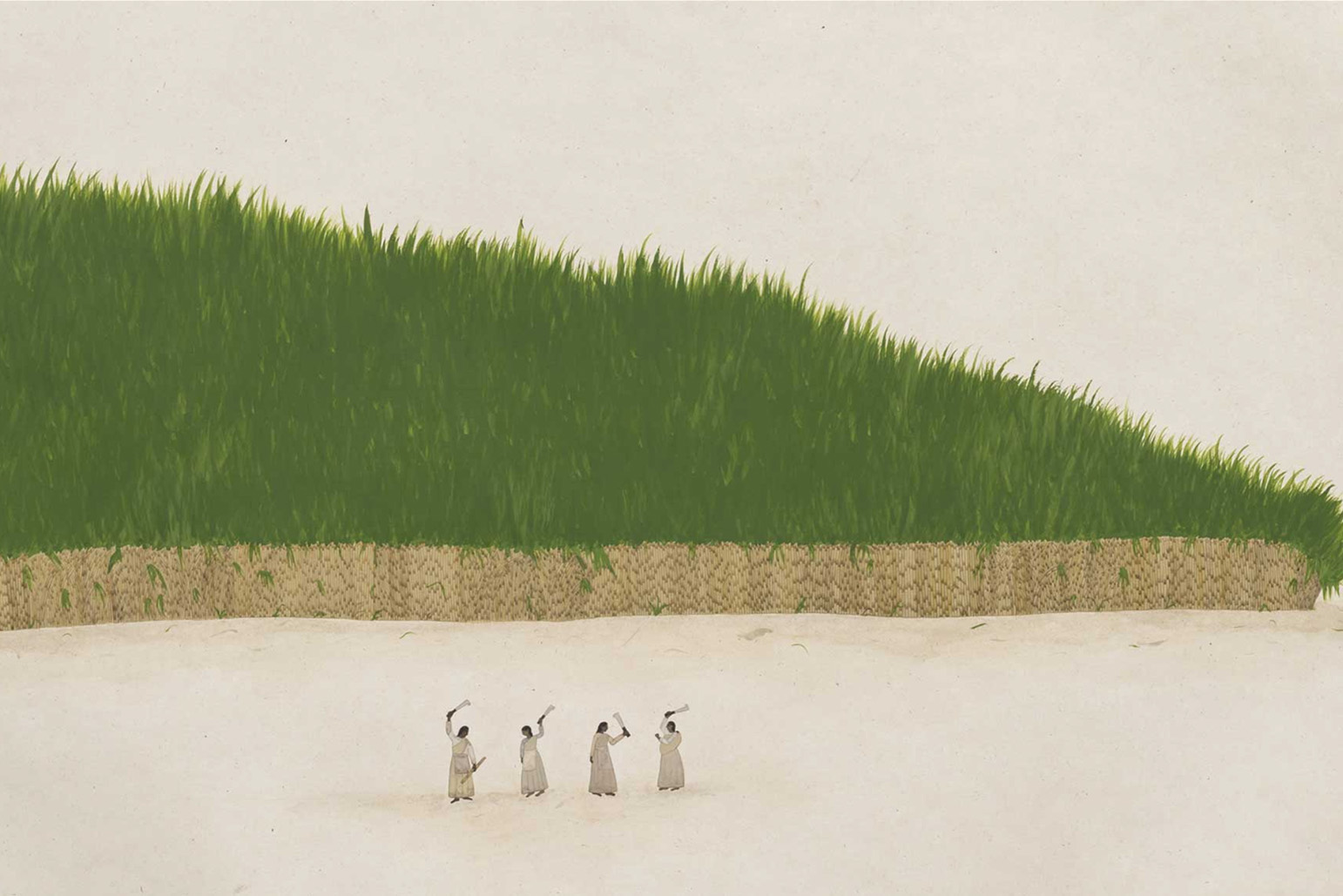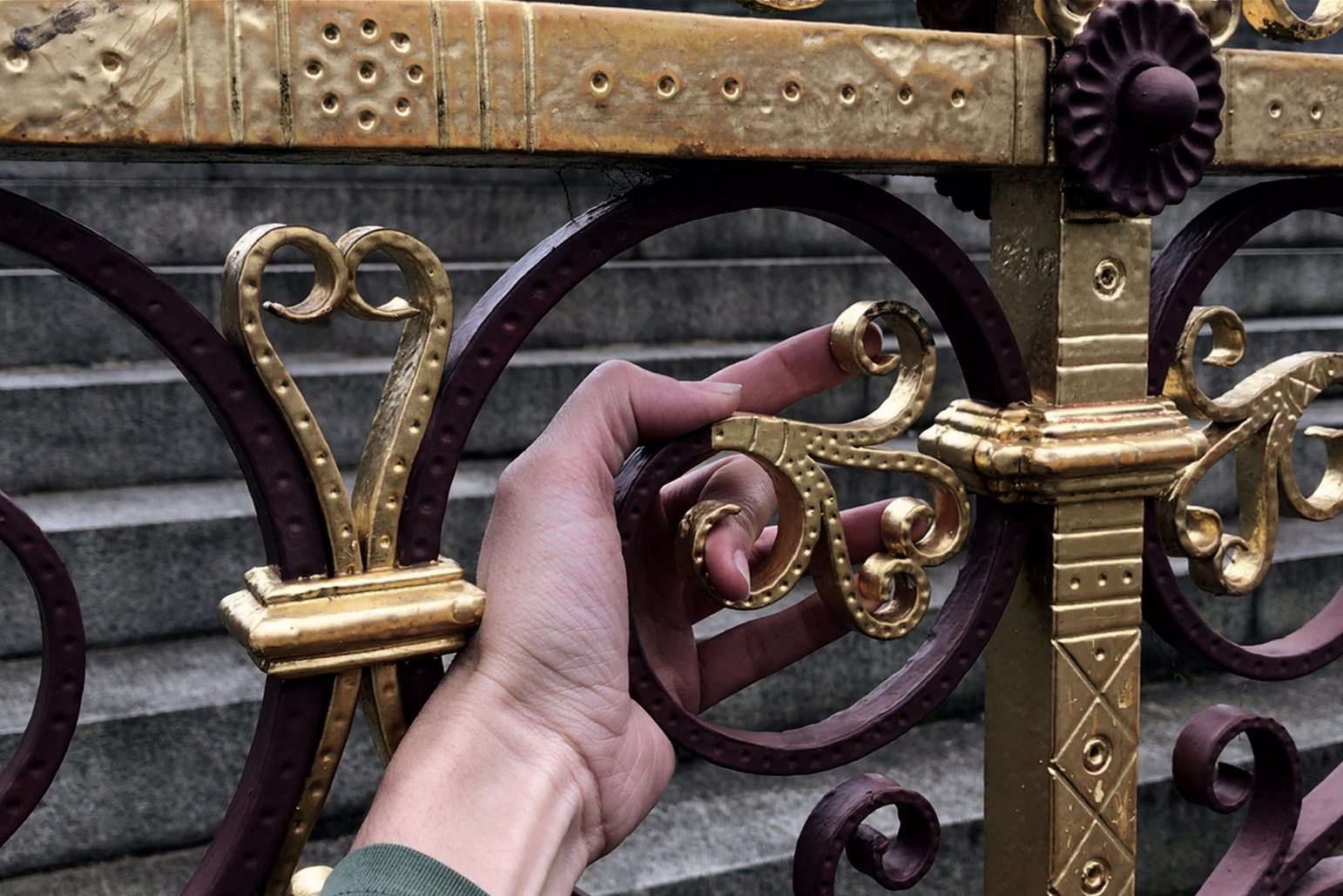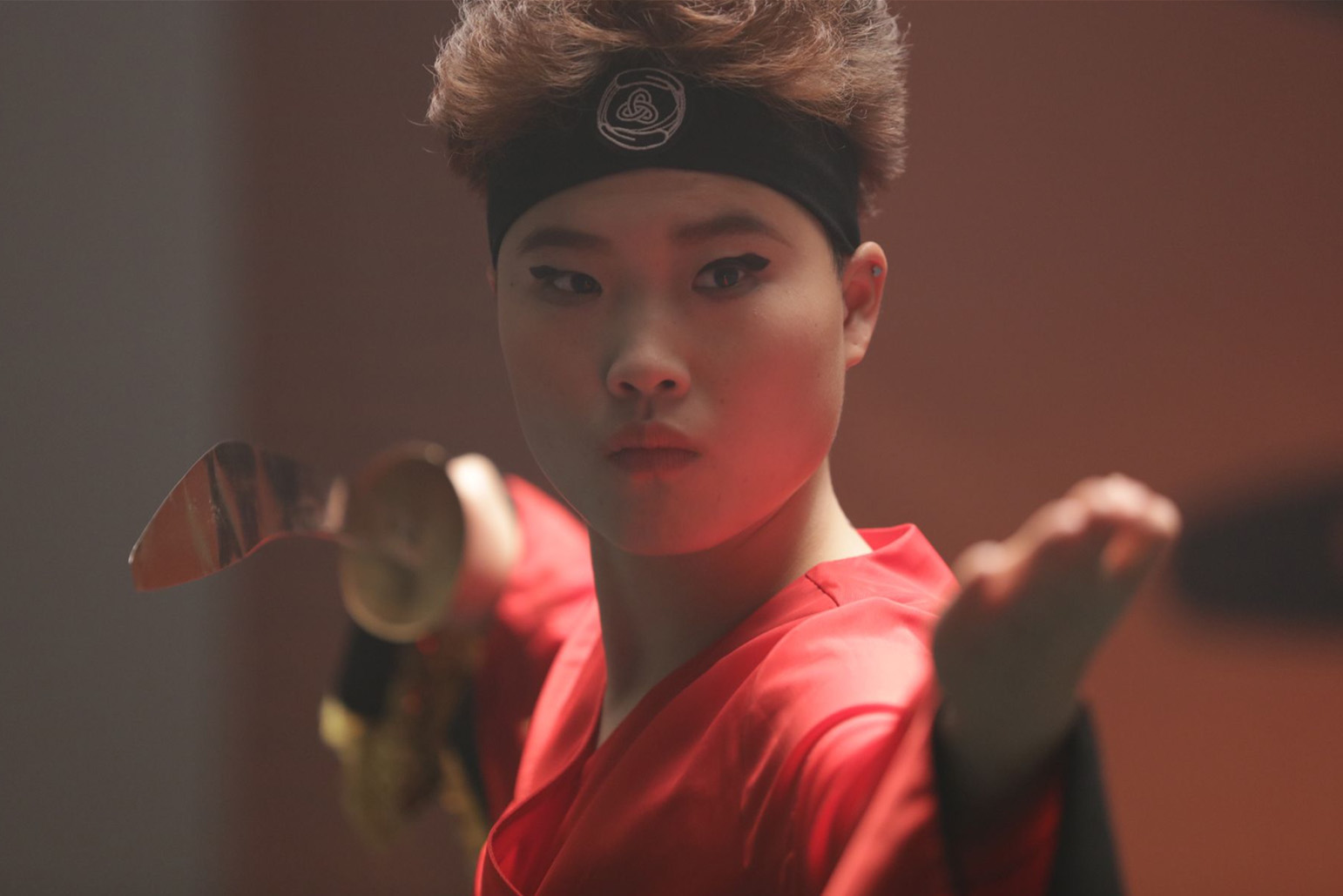


Pub-criticism is a fraught weathervane. A post-opening polemical discussion inevitably bears witness to emphatic declarations of praise or criticism intended to rouse laughter or scorn—a tease, regardless. On occasion true gems yield from the pressure. This is true of the current exhibitions at the Perth Institute for Contemporary Art, which have received interesting pub-commentary from punters. The variety of views I’ve heard suggests divisiveness.
For some, Wu Tsang’s video Duilian was praised for its bold presentation; the entirety of the PICA’s Central Galleries is engulfed in red curtains, guiding visitors immediately to Tsang’s looping video. For others, this seemed intensely self-indulgent—the one work dominating an excessive amount of space. The 26 minute video is a dramatic queer retelling of the relationship between Qiu Jin (秋瑾), the 19th century Chinese revolutionary, feminist, and poet, and the calligrapher and publisher Wu Zhiying (吳芝瑛). The film has garnered much attention during showings at Nottingham Contemporary, 356 S. Mission Rd., and MUMA (when it was included in the 2021 exhibition Language is a River, curated by Hannah Matthews and Melissa Ratliff). Whilst Duilian is a commanding cinematic experience, the presentation of this sole work in PICA’s Central Galleries is ambitious, questionable, and perhaps misjudged.
The question of space is relevant too for Sancintya Mohini Simpson’s ām / ammā / mā maram. A collection of disparate work, the exhibition consists of a succinct combo of painting, sculpture, poetry, photography, and “scent” (though, the schnoz of this critic was unable to sense anything). The show is mounted in PICA’s West End Gallery. This first floor gallery is perhaps PICA’s most versatile space. Certainly it is their most conventional. A white cube gallery with a couple of architectural eccentricities (unavoidable for galleries in heritage buildings), the space is just big enough to suit most kinds of work, but more intimate than the capacious Central Galleries.
Simpson’s first WA exhibition, ām / ammā / mā maram contains some exceptional individual works. There are four key groupings: pots, poems, paintings, and photographs. The paintings depict landforms on sheets of corrugated iron, sugar plantations. The pots are isolated in the centre of the gallery, placed on burnt tables, both seemingly charred in the same fire. The ceramics are haunting—are they urns? On the interfacing wall to the paintings are a series of old black-and-white photographs depicting the women who worked the fields. The poems provide a lens through-which to read the aforementioned work. Conceptually, the exhibition offers much. However, something seems not quite right upon viewing it as a whole. These four sets of works are broken into groups due to excessive spans of empty wall space—too much (which is something I rarely find myself thinking!). With the “room sheet” printed and provided its own wall, as if it were one of the works, it is hard not to speculate whether more had initially been intended for display.
Sancintya Mohini Simpson is a skilled maker of nuanced work—I am thinking particularly of her refined watercolour and gauche series, The Plantation, painted on richly textured handmade wasli paper. Oddly, these images, which were used to promote the exhibition, were not featured in the show. Perhaps their inclusion would have helped tie together the four disparate sections, and created a more intimate, full, gallery experience. Certainly there was room for them.
This issue of excessive space, of course, does not apply in the case of Sriwhana Spong’s video This Creature, which runs in the Screen Space on the first floor—the conventionality of the presentation prompting the viewer to focus on Spong’s excellent video. Filmed using her iPhone, the video is a POV view of Spong groping various bits of buildings and sculptures around London’s Hyde Park. A narration recites passages from The Book of Margery Kempe, a strange and intriguing text dating back to around 1436.1 Together, recitation and footage unite to form a weirdly erotic and bodily meditation on touch and movement. Unlike the expansive space that looms while viewing Duilian, the presentation of This Creature feels confident, intimate, and appropriate.
Going from the full-house that was Hatched to the sparseness of this current threesome is a bold contrast. Overall, these exhibitions are an odd trio. Like witnessing three friends winding each other up at the bar, a relationship is assumed but seems volatile, occasionally uneasy. Here, what troubles is that this discordance does not seem intentional. Nor does a logical or playful explanation seem apparent.
Wu Tsang, Duilian; Sancintya Mohini Simpson, ām / ammā / mā maram; Sriwhana Spong, This Creature, 4 Aug – 22 Oct 2023, Perth Institute of Contemporary Art.
1. Margery Kempe was a 15th century mystic who had visions of getting it on with Jesus. Kempe recorded these and other experiences by dictation in The Book of Margery Kempe, which is well worth a google.
Image credits:
1. Sancintya Mohini Simpson, The Plantation (detail), 2022, watercolour and gouache on handmade wasli paper, 6 panels each approx. 95 x 125cm irreg., 190 x 375cm overall, image courtesy the artist and Milani Gallery, Meanjin/Brisbane, photo: Carl Warner
2. Sriwhana Spong, This Creature, 2016 single-channel HD video, sound 14:55 minutes, image courtesy the artist © the artist and Michael Lett, Auckland/New Zealand
3. Wu Tsang, Duilian, 2016, single-channel colour video with sound, 26:16 minutes, image courtesy the artist, Galerie Isabella Bortolozzi/Berlin and M+, Hong Kong. © Wu Tsang
For some, Wu Tsang’s video Duilian was praised for its bold presentation; the entirety of the PICA’s Central Galleries is engulfed in red curtains, guiding visitors immediately to Tsang’s looping video. For others, this seemed intensely self-indulgent—the one work dominating an excessive amount of space. The 26 minute video is a dramatic queer retelling of the relationship between Qiu Jin (秋瑾), the 19th century Chinese revolutionary, feminist, and poet, and the calligrapher and publisher Wu Zhiying (吳芝瑛). The film has garnered much attention during showings at Nottingham Contemporary, 356 S. Mission Rd., and MUMA (when it was included in the 2021 exhibition Language is a River, curated by Hannah Matthews and Melissa Ratliff). Whilst Duilian is a commanding cinematic experience, the presentation of this sole work in PICA’s Central Galleries is ambitious, questionable, and perhaps misjudged.
The question of space is relevant too for Sancintya Mohini Simpson’s ām / ammā / mā maram. A collection of disparate work, the exhibition consists of a succinct combo of painting, sculpture, poetry, photography, and “scent” (though, the schnoz of this critic was unable to sense anything). The show is mounted in PICA’s West End Gallery. This first floor gallery is perhaps PICA’s most versatile space. Certainly it is their most conventional. A white cube gallery with a couple of architectural eccentricities (unavoidable for galleries in heritage buildings), the space is just big enough to suit most kinds of work, but more intimate than the capacious Central Galleries.
Simpson’s first WA exhibition, ām / ammā / mā maram contains some exceptional individual works. There are four key groupings: pots, poems, paintings, and photographs. The paintings depict landforms on sheets of corrugated iron, sugar plantations. The pots are isolated in the centre of the gallery, placed on burnt tables, both seemingly charred in the same fire. The ceramics are haunting—are they urns? On the interfacing wall to the paintings are a series of old black-and-white photographs depicting the women who worked the fields. The poems provide a lens through-which to read the aforementioned work. Conceptually, the exhibition offers much. However, something seems not quite right upon viewing it as a whole. These four sets of works are broken into groups due to excessive spans of empty wall space—too much (which is something I rarely find myself thinking!). With the “room sheet” printed and provided its own wall, as if it were one of the works, it is hard not to speculate whether more had initially been intended for display.
Sancintya Mohini Simpson is a skilled maker of nuanced work—I am thinking particularly of her refined watercolour and gauche series, The Plantation, painted on richly textured handmade wasli paper. Oddly, these images, which were used to promote the exhibition, were not featured in the show. Perhaps their inclusion would have helped tie together the four disparate sections, and created a more intimate, full, gallery experience. Certainly there was room for them.
This issue of excessive space, of course, does not apply in the case of Sriwhana Spong’s video This Creature, which runs in the Screen Space on the first floor—the conventionality of the presentation prompting the viewer to focus on Spong’s excellent video. Filmed using her iPhone, the video is a POV view of Spong groping various bits of buildings and sculptures around London’s Hyde Park. A narration recites passages from The Book of Margery Kempe, a strange and intriguing text dating back to around 1436.1 Together, recitation and footage unite to form a weirdly erotic and bodily meditation on touch and movement. Unlike the expansive space that looms while viewing Duilian, the presentation of This Creature feels confident, intimate, and appropriate.
Going from the full-house that was Hatched to the sparseness of this current threesome is a bold contrast. Overall, these exhibitions are an odd trio. Like witnessing three friends winding each other up at the bar, a relationship is assumed but seems volatile, occasionally uneasy. Here, what troubles is that this discordance does not seem intentional. Nor does a logical or playful explanation seem apparent.
Wu Tsang, Duilian; Sancintya Mohini Simpson, ām / ammā / mā maram; Sriwhana Spong, This Creature, 4 Aug – 22 Oct 2023, Perth Institute of Contemporary Art.
1. Margery Kempe was a 15th century mystic who had visions of getting it on with Jesus. Kempe recorded these and other experiences by dictation in The Book of Margery Kempe, which is well worth a google.
Image credits:
1. Sancintya Mohini Simpson, The Plantation (detail), 2022, watercolour and gouache on handmade wasli paper, 6 panels each approx. 95 x 125cm irreg., 190 x 375cm overall, image courtesy the artist and Milani Gallery, Meanjin/Brisbane, photo: Carl Warner
2. Sriwhana Spong, This Creature, 2016 single-channel HD video, sound 14:55 minutes, image courtesy the artist © the artist and Michael Lett, Auckland/New Zealand
3. Wu Tsang, Duilian, 2016, single-channel colour video with sound, 26:16 minutes, image courtesy the artist, Galerie Isabella Bortolozzi/Berlin and M+, Hong Kong. © Wu Tsang
